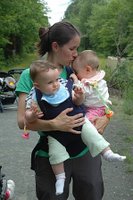Nature Strollers
The mission of the Nature Strollers is to support parents and grandparents in their role as primary interpreters of nature for their families; to provide opportunities for families to enjoy unstructured time outdoors; to familiarize families with local trails, refuges, sanctuaries and preserves; and to develop networks among families with a common interest in nature.
Contributors
Thursday, June 22, 2006
Friday, June 09, 2006
Goose Pond Mountain Created Wetlands, 09 June 2006
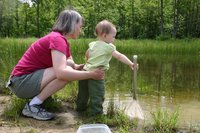
Laurel reflects on our outing at Goose Pond...
Encircled by hills and surrounded by old field and wetland, yet never more than a five minute walk from the parking lot, Goose Pond Mountain Area is an ideal spot for babies and young children.
It rained heavily over the past few days. The results of such weather were easy to see underfoot. Clusters of mushrooms had emerged from the sodden soil to decorate the edges of our path. Lots of tall, brown-gilled parasols and tons of little brown mushrooms were scattered about, but despite taking a class in mushrooms in grad school, these were all a bit too difficult to identify from memory.
It rained heavily over the past few days. The results of such weather were easy to see underfoot. Clusters of mushrooms had emerged from the sodden soil to decorate the edges of our path. Lots of tall, brown-gilled parasols and tons of little brown mushrooms were scattered about, but despite taking a class in mushrooms in grad school, these were all a bit too difficult to identify from memory.
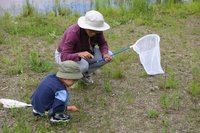
Anderson, a three-year-old, was on a mission to get to the pond. Sybil, his mother, mentioned that the last time they had dropped by Goose Pond, the large rafts of toad tadpoles that her sons had so enjoyed catching the week before had disappeared. I mentioned that my son, Sebastian, had noticed the same thing. We’d hoped to come on a day like the one Kat witnessed last year. The first day we walked at Goose Pond together Kat had shared her memory of hundreds of tiny toads hopping across the gravel path. But we did not visit the pond every day last week and somehow missed any mass emergence.
All three boys had benefited from the ease of capture of this tadpole species over the past weeks. In the shallow water, the toad tadpoles congregated in large groups. The boys didn’t have to get their feet wet to fetch a netfull for observation. We watched them grow in size and develop legs in the course of a few weeks. (Generally, I find toads the all around best amphibian for children to discover; they are slow in every stage.)
The clouds were swirling, patterns making a thrilling backdrop to the hills and reflecting in the still waters of the three ponds. We talked as we walked and scanned the trailside. The rocky fill was growing with a variety of native plants and non-native weeds. Kat spotted a butterfly.
Her capture of a little wood satyr—the butterfly not the mythological beast—was quick and efficient. So was the identification. Kat checked the spots on the underside of the grayish wings against the field guide to be sure, but we’d caught this species before in another location. It took the spectacular arrival of the orange and black monarch to put a full stop to our progress toward the pond. Butterfly nets were drawn and adult women stalked their prey as the monarch flew from flower to flower. We are green at this, and our first attempts were often failures. These would be followed by wild flailing and sometimes modified curses. This butterfly seemed to anticipate every move of the net. Chasing the creatures was so exhausting that it hardly seemed worth going after the painted lady butterfly that nectared nearby.
We tucked our nets back into our strollers and made our way down to the most shallow of the three ponds. On the way, Sybil and Anderson discovered a moving pebble. It was a newly transformed toad, only a half centimeter long and so well camouflaged that we had to step gingerly thereafter for fear of inadvertently squashing one.
Anderson, Kat and Sybil collected four of these and put them in the Tupperware container I’d brought for viewing pond animals. It was easy to see their minute limbs and mottled backs. It also made it possible to lift them up to show Acadia in her stroller. Previously very excited by swimming tadpoles in the same container, she was perhaps a little less vocal in her appreciation. Still, she pointed at each one in turn and protested when we let them go to made room for the pond creatures.

Water is always full of life, and the fact that these three ponds are man-made did not make them an exception. A blue damselfly sat primly, wings clasped on a rush. We heard the twang of a couple of green frogs, two of which were hidden at pond’s edge and leapt for cover as soon as we got too close. Catching these creatures is an exercise in patience. I mentioned that my son has engaged on the frustrating quest of frog hunting and I’ve had to tell him more than once that it may take a full summer to succeed.
Along with the butterfly nets Kat and I keep in our cars, I keep a few pond nets in my trunk for sharing. Anderson again showed himself very able with this tool, netting several tadpoles in one of his first attempts. These tadpoles looked different from the toad tadpoles having squarer heads a lighter coloration. We only found a few as they were dispersed amongst the aquatic plants. I savored the excitement in Anderson’s cry, “I caught one, I caught one!” It was a call I remembered from my own childhood summers.
As Sybil left the group to chase a monarch a hundred yards away, a tree swallow, back iridescent, made several swooping passes at the surface of the pond. Kat’s twins were quiet in their stroller, happy watching the shifting cloud cover or the reflective surface of the water. We’ll never know for sure, but I suspect the antics of frog-stalking and butterfly-chasing mommies were keeping them somewhat entertained.
I let Acadia out of her stroller at the boardwalk. She saw Anderson with his net, pulled another out of the back of the stroller and off she went. It is tiring to keep up with a toddler. On one visit she insisted on dragging her hand against the cedar railing and ended up with three splinters, another time she sat down in the shallows. I didn’t think I’d be able to get the muck out of her shoes. But once out of the stroller and they’ll insist on always being out. At least she kept pace well.
Anderson and his mother were in the lead, and they overheard an excited peenting coming from the skunk cabbage and pickerel weed. Startled, a juvenile water bird attempted to fly out of the dense cover. It made it about five feet before disappearing again into the greenery. The bird was dark brownish black and plain with a long neck. The glimpse was so brief that we had no recollection of its beak or feet. Was it a duckling, a grouse, a grebe? We will never know.
On the other side of the boardwalk, a path leads to the shore of the largest pond. Here the territory of bullfrogs and green frogs is announced in voices alternately twangy and deep. Anderson was disappointed by the paucity of water creatures in his net, and since we were all getting a bit tired and hungry we moved along.
Anderson and his mother were in the lead, and they overheard an excited peenting coming from the skunk cabbage and pickerel weed. Startled, a juvenile water bird attempted to fly out of the dense cover. It made it about five feet before disappearing again into the greenery. The bird was dark brownish black and plain with a long neck. The glimpse was so brief that we had no recollection of its beak or feet. Was it a duckling, a grouse, a grebe? We will never know.
On the other side of the boardwalk, a path leads to the shore of the largest pond. Here the territory of bullfrogs and green frogs is announced in voices alternately twangy and deep. Anderson was disappointed by the paucity of water creatures in his net, and since we were all getting a bit tired and hungry we moved along.
We stopped on the second boardwalk, overlooking the blue flag iris and cattails. Sybil peered down and was somewhat unsettled to find a loosely coiled snake resting in the sun where we had just been walking. It was very dull black with only a faint white line at the lip as an identifying mark. Later perusal of the field guide suggested a black rat snake. We photographed it until my approach frightened it into a cattail stand.
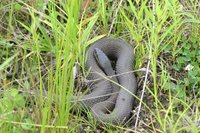
On our way out we paused to look at some white mushrooms, caps stained yellow bearing the characteristic ruffle around their stalk of the poisonous amanita clan. These we photographed as well. Then just before our exodus, again we noticed a reptilian presence. Motionless by the path, a second snake had settled artfully amongst the mushrooms. This one had the ghosts of long ago markings, saddles across its back, probably an older northern water snake. It posed for pictures, again until we got too close.
We left Goose Pond Mountain Area full of questions and answers. Minds were abuzz with the sound of bumblebees, eyes set to detect the smallest movement on the ground, and children happy and exhausted, ready to fall asleep on the car ride home.
Monday, June 05, 2006
Heritage Trail, 05 June 2006
Laurel reflects on our outing at the Heritage Trail...

Ginny, Kat and I are on the Heritage Trail. It’s breezy, high seventies, and much more comfortable than the last walk Kat and I took when the heat index was in the nineties. We related to Ginny a tale of that sweat-fest as we unloaded our gear...
As we approached the railroad bridge over a stream, I’d spotted a large black creature making its way through the underbrush. About thirty feet away and below where we stood on the embankment, it was hard to make out. Was it a baby bear? Could it be a beaver? The poison ivy and jewelweed at the water’s edge soon parted to reveal its identity. A huge snapping turtle lumbered from its cover as it moved toward the water.
A later peek at the field guide revealed that these creatures top out at around eighteen inches in carapace length. This one was closing in on the maximum. Kat left the trail while I watched the babies. She waded through the poison ivy with a later eruption of a single patch of blisters on her ankle the only price for some fine photographs.
The animal was not aggressive and did not display its characteristic threat stance—hissing menacingly, body lifted high on its thick legs. In fact, by the time Kat and I switched places and I’d tiptoed delicately between three-leaved dangers, he or she had already buried half its body beneath the browned, downward resting blades of a tussock sedge. I could only see its nostrils on the front end, but its heavily armored tail was clearly visible. Male snapping turtles are supposed to have longer tails than females, but without one of each for comparison, we were unable to make the call.
We didn’t expect the snapper to make a repeat appearance for Ginny and her four month old, Sawyer, but were looking forward to whatever came our way. Luckily, the weedy railbed was hopping with action. Very soon I glimpsed what may have been a yellow spotted forester, a day flying moth. It, too, headed for a patch of poison ivy, and I knew better than to follow.
Although Kat is the better net wielder, this day I was the only one armed. I brought a children’s butterfly net with a short handle that does not stick out too far from the basket under my stroller to trip me up.
A later peek at the field guide revealed that these creatures top out at around eighteen inches in carapace length. This one was closing in on the maximum. Kat left the trail while I watched the babies. She waded through the poison ivy with a later eruption of a single patch of blisters on her ankle the only price for some fine photographs.
The animal was not aggressive and did not display its characteristic threat stance—hissing menacingly, body lifted high on its thick legs. In fact, by the time Kat and I switched places and I’d tiptoed delicately between three-leaved dangers, he or she had already buried half its body beneath the browned, downward resting blades of a tussock sedge. I could only see its nostrils on the front end, but its heavily armored tail was clearly visible. Male snapping turtles are supposed to have longer tails than females, but without one of each for comparison, we were unable to make the call.
We didn’t expect the snapper to make a repeat appearance for Ginny and her four month old, Sawyer, but were looking forward to whatever came our way. Luckily, the weedy railbed was hopping with action. Very soon I glimpsed what may have been a yellow spotted forester, a day flying moth. It, too, headed for a patch of poison ivy, and I knew better than to follow.
Although Kat is the better net wielder, this day I was the only one armed. I brought a children’s butterfly net with a short handle that does not stick out too far from the basket under my stroller to trip me up.
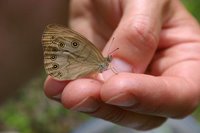
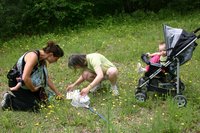
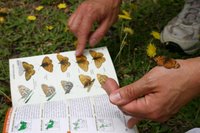
I chased several intriguing subjects and was soon three for three: First a butterfly we thought might be the familiar little wood satyr, but this one had too many spots on the reverse of the wings—an eyed brown! Second an American lady conveniently appeared as if to let us learn the difference between it and the painted lady we’d caught on the last, sweltering walk. Finally, out of the woods and right into my net flew a huge ichneumon wasp. Its buzzing had alerted me to its approach, and I’d hardly lifted the net when it bumbled in, so I could not claim any increase in skill.
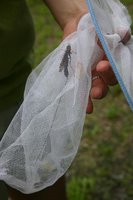
The ichneumon’s impressive ovipositor worried my companions. Could that four inch long spike attached to the large wasp’s abdomen be a stinger? Thankfully, for humans at least, it is more like a drill, able to penetrate bark and lay eggs in larvae hiding within the wood.
I tried to release the wasp from the net slowly so the others, who unlike me, remembered their cameras, could get a shot, but it slipped through my fingers, ovipositor flexible and feeling plastic to the touch.
We passed several open snapping turtle nests with shell debris scattered about and two intact eggs in one. It is egg laying season. Last visit we saw turtle tracks and shell and tail drags crossing the trail and evidence of several false nests. I hold my tongue; many of these may have been dug up by nest predators rather than hatchlings. The painted turtles have been hatching out though; in May we heard reports from other walkers of baby turtles crossing the path, and we found a skeletonized specimen beside the path.
Farther along the trail, Ginny spots something moving in the yellow hawkweed. I took off in the direction she pointed and netted a snowberry clearwing, a day flying moth with a huge, fuzzy body and clear wings. I showed it to my toddler. She got very excited and began to mimic our constant pointing. When she is on foot, she will stop at the sight of an ant, squat and point and say “bug, bug, bug!” I guess our excitement is infectious. We show them our joy in nature through our behavior.

As we strolled on, Sawyer sleeping in his sling, the babies happy in their strollers, Kat checked the tree holes she had spotted on an earlier trip hoping to catch an inhabitant on film.
The twins, Lily and Penelope, started getting fussy at the bridge where we had seen the snapping turtle. Kat and Ginny got some good shots of a couple of tiger swallowtails nectaring on a viburnum. We looked down into the river to see if the crayfish were active, but the surface of the water was not still and its shallow depth was impenetrable.
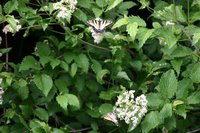
Increasing complaints required Kat to carry one baby in the front pack and the other in her arms. Luckily she had Ginny, baby in sling, available to push the stroller. As we rolled back to the parking lot, we were paralleled by a wild turkey and crossed paths with a woodchuck and a cottontail. The clock in my car said two hours had passed; it felt like we were just getting started.
